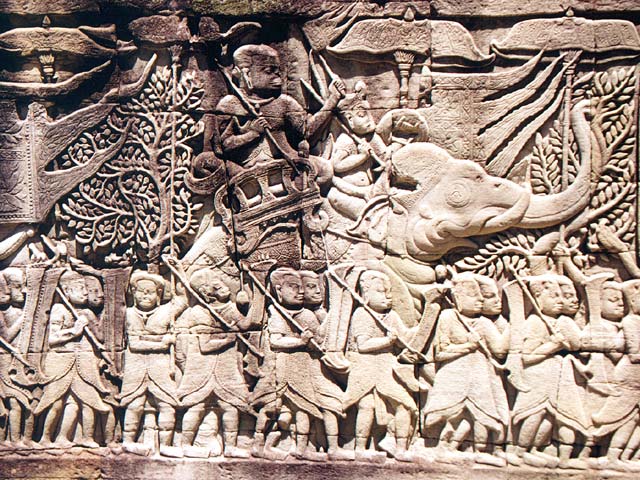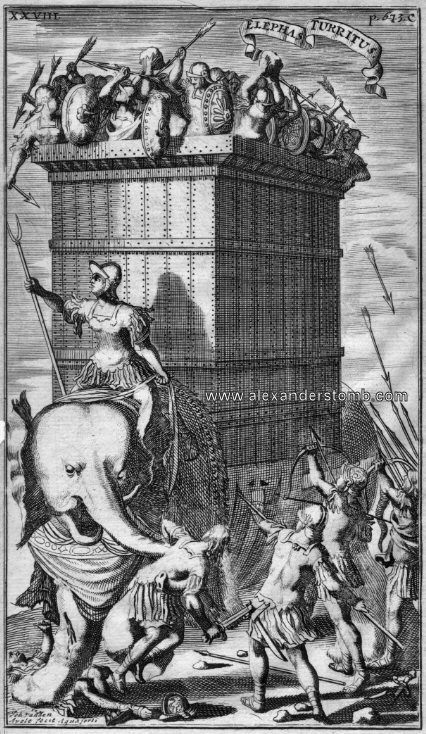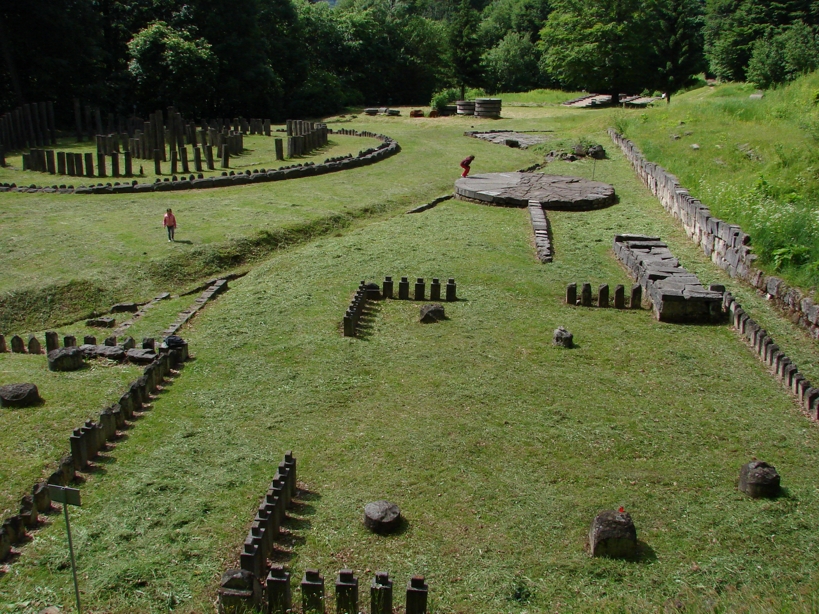Friday, December 16, 2011
Tuesday, November 8, 2011
Acidava_Ancient cities
Acidava (Acidaua) was a Dacian and later Roman fortress on the Olt river near the lower Danube.[1] The settlements remains are located in today's Enoşeşti, Olt County, Romania.
After the Roman conquest of Dacia by Roman Emperor Trajan, Acidava became a civilian and military center, with castra being built in the area. Acidava was part of the Limes Alutanus, a line of fortifications built under emperor Hadrian running north-south along the Alutus - the Olt river.[2] The function of the limes was to monitor the Roxolani to the east and deter any possible attacks.[3]
Acidava is depicted in the Tabula Peutingeriana between Romula and Rusidava. The same document depicts a second Acidava, between Cedoniae and Apula, but some authors believe it is actually a copy error[4] and the correct name is Sacidava, another Dacian town.
After the Roman conquest of Dacia by Roman Emperor Trajan, Acidava became a civilian and military center, with castra being built in the area. Acidava was part of the Limes Alutanus, a line of fortifications built under emperor Hadrian running north-south along the Alutus - the Olt river.[2] The function of the limes was to monitor the Roxolani to the east and deter any possible attacks.[3]
Acidava is depicted in the Tabula Peutingeriana between Romula and Rusidava. The same document depicts a second Acidava, between Cedoniae and Apula, but some authors believe it is actually a copy error[4] and the correct name is Sacidava, another Dacian town.







Monday, November 7, 2011
Damascus - Ancient City of Syria
Damascus (Arabic: دِمَشق Dimašq, Ottoman Turkish: شام Shām), commonly known in Syria as Al Sham (Arabic: الشام Al Shām), and as the City of Jasmine (Arabic: مدينة الياسمين Madīnatu 'i Yāsmīn), is the capital and the second largest city of Syria after Aleppo, both are part of the country's 14 governorates. In addition to being one of the oldest continuously inhabited cities in the world, Damascus is a major cultural and religious center of the Levant. The city has an estimated population of 2,517,750 (July 2010 est.) .[1]
Located in southwestern Syria, Damascus is the center of a large metropolitan area of 2.4 million people (2004).[3] Geographically embedded on the eastern foothills of the Anti-Lebanon mountain range 80 kilometres (50 mi) inland from the eastern shore of the Mediterranean on a plateau 680 metres (2,230 ft) above sea-level, Damascus experiences a semi-arid climate due to the rain shadow effect. The Barada River flows through Damascus.
First settled in the 2nd millennium BC, it was chosen as the capital of the Umayyad Caliphate from 661 to 750. After the victory of the Abbasid dynasty, the seat of Islamic power was moved to Baghdad. Damascus saw a political decline throughout the Abbasid era, only to regain significant importance in the Ayyubid and Mamluk periods. During Ottoman rule, the city decayed completely while maintaining a certain cultural prestige. Today, it is the seat of the central government and all of the government ministries. Damascus was chosen as the 2008 Arab Capital of Culture.[4]
Located in southwestern Syria, Damascus is the center of a large metropolitan area of 2.4 million people (2004).[3] Geographically embedded on the eastern foothills of the Anti-Lebanon mountain range 80 kilometres (50 mi) inland from the eastern shore of the Mediterranean on a plateau 680 metres (2,230 ft) above sea-level, Damascus experiences a semi-arid climate due to the rain shadow effect. The Barada River flows through Damascus.
First settled in the 2nd millennium BC, it was chosen as the capital of the Umayyad Caliphate from 661 to 750. After the victory of the Abbasid dynasty, the seat of Islamic power was moved to Baghdad. Damascus saw a political decline throughout the Abbasid era, only to regain significant importance in the Ayyubid and Mamluk periods. During Ottoman rule, the city decayed completely while maintaining a certain cultural prestige. Today, it is the seat of the central government and all of the government ministries. Damascus was chosen as the 2008 Arab Capital of Culture.[4]









Thursday, November 3, 2011
Thursday, October 13, 2011
War Elephants in Ancient and Medieval China
The Asiatic Elephant (Elephas maximus), taken, tamed, and trained for civil and military purposes in India and Indochina since antiquity, was once widespread in China, and occasionally employed in battle there. Archeological and literary remains attest to its presence in the valley of the Yellow River in Shang times, but none seem to have survived in the dominions of the kings of Chou. Indeed tradition credited the heroic founders of that dynasty with driving these behemoths from the realm of the Sons of Heaven. During the Han dynasty they were regarded as characteristic animals of Southern Yiieh, that is, of modern Lingnan.

Nonetheless many individual beasts and sometimes even herds are reported from central as well as southern China during the first ten centuries of the Christian era. Groups of elephants were seen in Honan and Hupeh in the fifth century, while large herds still roamed the forests of northern Kwangtung. In the sixth century, several hundreds ravaged the crops in Huai-nan, a small group appeared at Chien-k’ang, and, astonished by the appearance of a solitary straggler in central Honan, the Toba overlords declared a new era, named “Primal Elephant”. Elephants were still abundant in the mountainous parts of Kwangtung in the ninth century, and we are not surprised to read of herds in coastal Lingnan in the tenth.





Nonetheless many individual beasts and sometimes even herds are reported from central as well as southern China during the first ten centuries of the Christian era. Groups of elephants were seen in Honan and Hupeh in the fifth century, while large herds still roamed the forests of northern Kwangtung. In the sixth century, several hundreds ravaged the crops in Huai-nan, a small group appeared at Chien-k’ang, and, astonished by the appearance of a solitary straggler in central Honan, the Toba overlords declared a new era, named “Primal Elephant”. Elephants were still abundant in the mountainous parts of Kwangtung in the ninth century, and we are not surprised to read of herds in coastal Lingnan in the tenth.




Thursday, April 14, 2011
Acidava.....Tour of ancient City
Acidava (Acidaua) was a Dacian and later Roman fortress on the Olt river near the lower Danube.[1] The settlements remains are located in today's Enoşeşti, Olt County, Romania.
After the Roman conquest of Dacia by Roman Emperor Trajan, Acidava became a civilian and military center, with castra being built in the area. Acidava was part of the Limes Alutanus, a line of fortifications built under emperor Hadrian running north-south along the Alutus - the Olt river.[2] The function of the limes was to monitor the Roxolani to the east and deter any possible attacks.[3]
Acidava is depicted in the Tabula Peutingeriana between Romula and Rusidava. The same document depicts a second Acidava, between Cedoniae and Apula, but some authors believe it is actually a copy error[4] and the correct name is Sacidava.


After the Roman conquest of Dacia by Roman Emperor Trajan, Acidava became a civilian and military center, with castra being built in the area. Acidava was part of the Limes Alutanus, a line of fortifications built under emperor Hadrian running north-south along the Alutus - the Olt river.[2] The function of the limes was to monitor the Roxolani to the east and deter any possible attacks.[3]
Acidava is depicted in the Tabula Peutingeriana between Romula and Rusidava. The same document depicts a second Acidava, between Cedoniae and Apula, but some authors believe it is actually a copy error[4] and the correct name is Sacidava.












Sunday, March 27, 2011
10 Oldest Mosques in the World
01. Quba Mosque, Saudi Arabia
First Built: 622
The designation of the oldest mosque in the world requires careful use of definitions, and must be divided into two parts, the oldest in the sense of oldest surviving building, and the oldest in the sense of oldest mosque congregation. Even here, there is the distinction between old mosque buildings that have been in continuous use as mosques, and those that have been converted to other purposes; and between buildings that have been in continuous use as mosques and those that were shuttered for many decades. In terms of congregations, they are distinguished between early established congregations that have been in continuous existence, and early congregations that ceased to exist (wikipedia). 09 More after the break...
02. Al-Masjid al-Nabawi, Saudi Arabia
First Built: 622
03. Masjid al-Qiblatain, Saudi Arabia
03. Masjid al-Qiblatain, Saudi Arabia
First Built: 623
04. Jawatha Mosque, Saudi Arabia
First Built: 629
05. Masjid al-Haram, Saudi Arabia
First Built: 638
06. Great Mosque of Kufa, Iraq
First Built: 639
07. Mosque of Uqba, Tunisia
First Built: 670
08. Imam Hussain Mosque, Iraq
First Built: 680
09. Al-Aqsa Mosque, Jerusalem
First Built: 705
10. Al-Zaytuna Mosque, Tunisia
First Built: 709
Wednesday, March 23, 2011
Abacaenum.....Tour of ancient City
Abacaenum (Greek: Ἀβάκαινον[1]; Ἀβάκαινα[2]), was an ancient city of Sicily, situated about 6.5 km from the north coast, between Tyndaris (modern Tindari) and Mylae (modern Milazzo), and 13 km from the former city.
History
It was a city of the Siculi, and does not appear to have ever received a Greek colony, though it partook largely of the influence of Greek art and civilization. Its territory originally included that of Tyndaris, which was separated from it by the elder Dionysius when he founded that city in 396 BCE[3]. From the way in which it is mentioned in the wars of Dionysius, Agathocles, and Hieron[4], it is clear that it was a place of power and importance: but from the time of Hieron it disappears from history, and no mention is found of it in the Verrine orations of Cicero. Its name is, however, found in Ptolemy[5], so that it appears to have still continued to exist in his day. Its decline was probably owing to the increasing prosperity of the neighbouring city of Tyndaris.
There can be little doubt that the ruins visible in the time of Fazello, at the foot of the hill on which the modern town of Tripi is situated, were those of Abacaenum. He speaks of fragments of masonry, prostrate columns, and the vestiges of walls, indicating the site of a large city, but which had been destroyed to its foundations.[6]
It was a city of the Siculi, and does not appear to have ever received a Greek colony, though it partook largely of the influence of Greek art and civilization. Its territory originally included that of Tyndaris, which was separated from it by the elder Dionysius when he founded that city in 396 BCE[3]. From the way in which it is mentioned in the wars of Dionysius, Agathocles, and Hieron[4], it is clear that it was a place of power and importance: but from the time of Hieron it disappears from history, and no mention is found of it in the Verrine orations of Cicero. Its name is, however, found in Ptolemy[5], so that it appears to have still continued to exist in his day. Its decline was probably owing to the increasing prosperity of the neighbouring city of Tyndaris.
There can be little doubt that the ruins visible in the time of Fazello, at the foot of the hill on which the modern town of Tripi is situated, were those of Abacaenum. He speaks of fragments of masonry, prostrate columns, and the vestiges of walls, indicating the site of a large city, but which had been destroyed to its foundations.[6]
Coinage
There are found coins of Abacaenum, both in silver and copper. The boar and acorn, which are the common type of the former, evidently refer to the great forests of oak which still cover the neighboring mountains, and afford pasture to large herds of swine.



Subscribe to:
Posts (Atom)
















